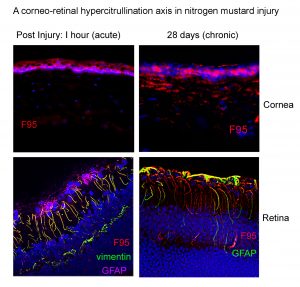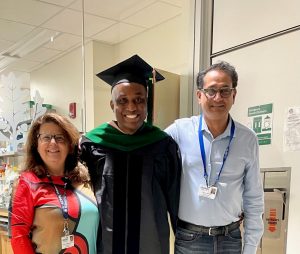Mohan lab publishes on a novel mechanism of retinal destruction from chemical injuries
A major enigma for first responders and emergency workers when treating civilian populations exposed to chemical injuries is not knowing the real extent of ocular damage. The Mohan lab has established in a new research article (see below) that the internal neurosensory retina is just as vulnerable to nitrogen mustard, beyond the obvious injured cornea at the anterior aspect of the eye. This study was funded by the NIH Counteract program (https://today.uconn.edu/2022/01/uconn-health-researcher-investigates-treatment-for-eye-injuries-from-mass-chemical-weapons-attacks/) to investigate nitrogen mustard injury an analog of the chemical warfare agent sulfur mustard. The Mohan lab has discovered that corneal and retinal hypercitrullination occur concurrently and, as such, their findings identify a common mechanistic thread that underlies corneal and retinal pathology. Over a decade ago, his lab serendipitously discovered that alkali injury caused retinal hypercitrullination and published pioneering work on this ocular injury mechanism. This time with nitrogen mustard, Mohan points out, it was straight forward scientific deduction given the similar corrosive nature of mustard agents.
Lead author Ezigobobiara (Ezii) Umejiego is credited for having developed the mouse model to study this toxin. He graduates with a combined MD-MPh from UConn School of Medicine and Public Health will go into ophthalmology residency. Ricky Paramo, a co-first author senior medical student from UConn School of Medicine, moves into clinical research in ophthalmology at Monterfiore/Einstein.
The article can be found here:
https://www.sciencedirect.com/science/article/abs/pii/S0014483523001069?via%3Dihub

